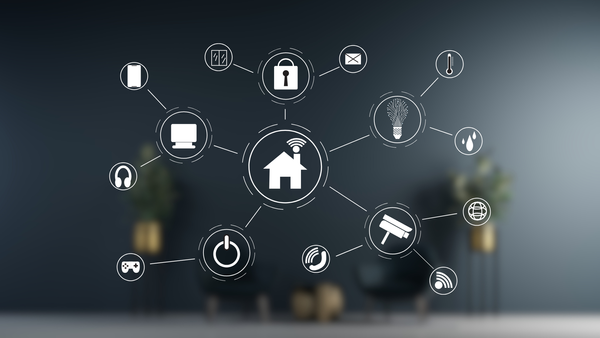The Pros and Cons of Using a Guest Network for IOT Devices

Although isolating your smart devices on a guest network can strengthen home security, it’s not a one-size-fits-all solution.
The convenience of guest networks
Thanks to technological advancements, our lives are growing steadily more interconnected, and our homes are following suit, becoming smarter and more autonomous.
Smart TVs, light bulbs, thermostats, doorbells, baby monitors, and even kitchen appliances are part of the modern Internet of Things (IoT) ecosystem.
On the downside, these devices often have minimal built-in security, leaving them highly vulnerable to cybercriminals.
Arguably, one of the easiest ways to protect your home network against cyberattacks is by isolating vulnerable IoT devices using a guest network.
What is a guest network?
A guest network is a separate access point created specifically to isolate visitors or secondary devices from your main network. It has its own name (SSID) and password and typically prevents connected devices from interacting with those on the primary network.
Originally designed for houseguests to use the internet without accessing your personal files or devices, the guest network is now gaining popularity as a makeshift security tool for isolating less-secure IoT devices.
Why IoT devices pose security risks
Many IoT devices are designed with simplicity and convenience in mind. Unfortunately, that often means security gets overlooked. These devices often lack:
- Frequent firmware updates
- Robust authentication mechanisms
- End-to-end encryption
- Transparent security documentation
Threat actors frequently target IoT devices to create botnets, conduct surveillance or pivot to more valuable devices on the same network. Once they breach one IoT device, they can move laterally on the network, attacking other, more valuable devices such as laptops, smartphones, and data-rich systems.
The pros of using guest networks for IoT devices
Network segmentation is generally perceived as one of the most effective ways to minimize communication between various devices on your home network.
Reasons to isolate IoT devices in your household in a guest network include:
1. Network segmentation and isolation
The most significant advantage of placing IoT devices on a guest network is the isolation it provides. If a smart bulb, sensor or camera gets hacked, the attacker is confined to the guest network and can’t directly reach more valuable devices, such as your laptop or NAS (network-attached storage).
Segmentation typically acts as a “firewall by design.” Even if the IoT device is compromised, the rest of your data remains protected.
2. Reduced risk of lateral movement
Threat actors often penetrate deeper into your home network’s defenses by jumping from one vulnerable device to another until they eventually reach a high-value target.
By segregating devices that don’t need to communicate with your primary systems, you limit the attack surface.
If your home network is compromised, perpetrators won’t be able to weaponize low-tier devices such as smart thermostats or sensors to snoop on your emails or gain access to your work laptop.
3. Minimized vulnerability impact
IoT manufacturers are notoriously slow at patching vulnerabilities, and some even abandon their devices shortly after releasing them. Placing such devices on a guest network minimizes the impact of unpatched vulnerabilities.
Even if threat actors identify a zero-day exploit on one of your smart devices, they won’t be able to jeopardize the security of your entire home network.
4. Simplified network management
Keeping IoT devices isolated on a guest network simplifies the way you monitor and manage bandwidth usage. Some routers enable you to throttle bandwidth or restrict internet access on guest networks, helping maintain performance for devices on your main network.
This separation can also simplify troubleshooting by preventing IoT-related traffic from bottlenecking your main network.
5. Easier device identification
With all IoT devices grouped under a single SSID, identifying them on your router becomes more manageable. You’ll know that everything connected to the guest SSID is either a smart home device or an automation accessory, aiding you in auditing and inventory processes.
The cons of using a guest network for IoT devices
Isolating all your IoT devices on a dedicated guest network should be approached with some considerations in mind.
1. Limited inter-device communication
Some IoT devices require local communication with other devices to function properly. For instance, smart lights often require communication with your phone or hub, and your voice assistant may need to connect to your smart TV or speaker. If these devices are on separate networks, compatibility issues can arise.
Certain routers allow inter-network communication, but this undermines the isolation and defeats the purpose of segmentation.
2. Lack of granular control
Most consumer-grade routers offer limited customization for guest networks, meaning you may not be able to set firewall rules, restrict port access or monitor traffic in detail.
This could limit your ability to adjust security settings for specific devices. Enterprise-grade solutions or mesh systems may offer more control, but at a higher cost and complexity level.
3. Potential performance bottlenecks
Depending on your router, guest networks may have lower bandwidth allocation or priority, which can lead to performance issues, particularly for data-intensive devices and activities (e.g., video streaming).
Additionally, the router can be overwhelmed when managing two networks, which can cause latency spikes that affect both the guest and primary networks.
4. Device setup difficulties
Some IoT devices are challenging to set up or configure on a guest network, particularly when the setup process requires communication with a phone or tablet on the main network.
Workarounds can involve temporarily switching your phone to the guest network or allowing limited access between networks. However, users unfamiliar with advanced router settings might find these solutions frustrating or error-prone, making them far from being ideal.
5. Not a silver bullet
While using a guest network for IoT devices can significantly improve security, it’s not a complete solution. A misconfigured router, a vulnerable device with an open port, or a default password can still expose you to security risks.
Guest networks should be viewed as an additional security layer rather than a cure-all.
Best practices for using a guest network with IoT devices
If you decide that segregating IoT devices on a guest network works for you, here are some tips to maximize its effectiveness:
- Rename the guest network SSID to reflect its purpose (e.g., “Home-IoT” rather than “Guest”)
- Use a strong, unique password instead of leaving it open or using a default password
- Disable guest-to-LAN communication if your router allows it. This way, you’ll block the guest network from accessing devices on the main network
- Turn off SSID broadcasting if you don’t want others to see your IoT network name
- Regularly audit connected devices to identify unauthorized connections
- Enable automatic firmware updates on all IoT devices if possible
- Use WPA3 encryption, or, at minimum, WPA2 for the guest network
- Disable UPNP (Universal Plug and Play) if you don’t need it, as it can expose your network to outside threats
Should you use a guest network for IoT devices?
The answer depends on your home setup, risk tolerance and technical savvy.
If you have a wide range of IoT devices and you’re concerned about security, isolating them on a guest network is a simple and effective way to protect your digital ecosystem. It requires minimal configuration and yields substantial benefits.
However, if your smart home devices need to communicate directly with your phone, TV, or other devices on your main network, you’ll need to ensure they aren’t impeded by segmentation. In such cases, consider alternative isolation strategies, such as VLANs or upgrading to a router with advanced traffic management capabilities.
Conclusion
While the growth of IoT devices in modern households has brought convenience, it has also introduced caveats, forcing users to adopt smarter, layered security practices.
Setting up a guest network specifically for IoT devices is one of the most accessible and effective methods for enhancing your home network’s security.
While it has its limitations, the benefits of isolating vulnerable devices far outweigh the risks for most users. Combined with other security elements, such as strong passwords, good network hygiene and regular firmware updates, using a guest network can significantly reduce your exposure to digital threats.
Frequently asked questions about using guest networks for IoT devices
Can I use the same guest network for both visitors and IoT devices?
While technically possible, it’s not recommended. Visitor devices can introduce malware or attempt to communicate with your IoT devices. Using a separate guest network or VLAN for each use case, if the router supports it, is definitely a better choice.
Do all routers support guest networks?
No. Entry-level or older routers may lack this functionality. If you want to use a guest network for your IoT devices, consider upgrading to a modern router or mesh system that supports multiple SSIDs and guest network management.
What if my IoT devices stop working when moved to a guest network?
Some devices rely on local communication to function properly. Try connecting your control device (e.g., smartphone) to the same guest network during setup, or consult your router’s settings to allow limited inter-network access if needed.
tags
Author
Vlad's love for technology and writing created rich soil for his interest in cybersecurity to sprout into a full-on passion. Before becoming a Security Analyst, he covered tech and security topics.
View all postsRight now Top posts
Recruitment Scam Alert: Fraudsters Impersonate Bitdefender in Fake Job Interviews
October 13, 2025
What are Roblox Executors and Why Do Parents Really Need to Know About Them
October 10, 2025
How to Outsmart Today’s Sneakiest Phishing Scams
October 10, 2025
FOLLOW US ON SOCIAL MEDIA
You might also like
Bookmarks









